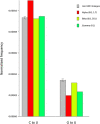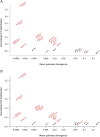The substitution spectra of coronavirus genomes
- PMID: 34518866
- PMCID: PMC8499949
- DOI: 10.1093/bib/bbab382
The substitution spectra of coronavirus genomes
Abstract
The severe acute respiratory syndrome coronavirus 2 (SARS-CoV-2) pandemic has triggered an unprecedented international effort to sequence complete viral genomes. We leveraged this wealth of information to characterize the substitution spectrum of SARS-CoV-2 and to compare it with those of other human and animal coronaviruses. We show that, once nucleotide composition is taken into account, human and most animal coronaviruses display a mutation spectrum dominated by C to U and G to U substitutions, a feature that is not shared by other positive-sense RNA viruses. However, the proportions of C to U and G to U substitutions tend to decrease as divergence increases, suggesting that, whatever their origin, a proportion of these changes is subsequently eliminated by purifying selection. Analysis of the sequence context of C to U substitutions showed little evidence of apolipoprotein B mRNA editing catalytic polypeptide-like (APOBEC)-mediated editing and such contexts were similar for SARS-CoV-2 and Middle East respiratory syndrome coronavirus sampled from different hosts, despite different repertoires of APOBEC3 proteins in distinct species. Conversely, we found evidence that C to U and G to U changes affect CpG dinucleotides at a frequency higher than expected. Whereas this suggests ongoing selective reduction of CpGs, this effect alone cannot account for the substitution spectra. Finally, we show that, during the first months of SARS-CoV-2 pandemic spread, the frequency of both G to U and C to U substitutions increased. Our data suggest that the substitution spectrum of SARS-CoV-2 is determined by an interplay of factors, including intrinsic biases of the replication process, avoidance of CpG dinucleotides and other constraints exerted by the new host.
Keywords: RNA viruses; SARS-CoV-2; coronavirus; substitutions; transitions; transversions.
© The Author(s) 2021 Published by Oxford University Press.
Figures







